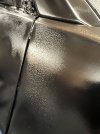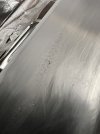Sugar Elf Creations
Promoted Users
So I sprayed my door jams about 5 days ago with Euro Clear. (Reduced epoxy, wait overnight, black base, wait one more night, clear next morning.
There were some edges of clear on to the flat parts of the panels. I blocked those areas with 800 to get it flat, but there was still a little bit of clear on the panels.
Today I went to put base coat on the panels and the edges of the clear started to crinkle, crack, and ever so slightly wrinkle.
When I sprayed the second coat of base you can’t see it anymore but as it flashes you can see the crinkling. Given that the “wet” paint hides it, will the clear hide this? Have any of you had this issue? Was the clear just too fresh to spray base over it?
I’ve painted over bc/cc many times where the paint was sanded back to all the layers without issue, but I’m guessing the paint wasn’t cured enough for the reducer in the base coat and it reacted with the fresh clear. Edges.
Note that it didn’t affect the clear where there isn’t an edge, only on the edges.
There were some edges of clear on to the flat parts of the panels. I blocked those areas with 800 to get it flat, but there was still a little bit of clear on the panels.
Today I went to put base coat on the panels and the edges of the clear started to crinkle, crack, and ever so slightly wrinkle.
When I sprayed the second coat of base you can’t see it anymore but as it flashes you can see the crinkling. Given that the “wet” paint hides it, will the clear hide this? Have any of you had this issue? Was the clear just too fresh to spray base over it?
I’ve painted over bc/cc many times where the paint was sanded back to all the layers without issue, but I’m guessing the paint wasn’t cured enough for the reducer in the base coat and it reacted with the fresh clear. Edges.
Note that it didn’t affect the clear where there isn’t an edge, only on the edges.








